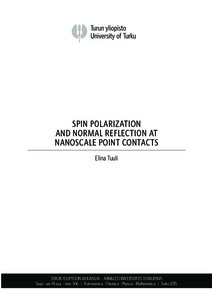Spin Polarization and Normal Reflection at Nanoscale Point Contacts
Tuuli, Elina (2015-02-14)
Spin Polarization and Normal Reflection at Nanoscale Point Contacts
Tuuli, Elina
(14.02.2015)
Turun yliopisto Annales Universitatis Turkuensis A I 506
Julkaisun pysyvä osoite on:
https://urn.fi/URN:ISBN:978-951-29-6012-5
https://urn.fi/URN:ISBN:978-951-29-6012-5
Kuvaus
Siirretty Doriasta
ei tietoa saavutettavuudesta
ei tietoa saavutettavuudesta
Tiivistelmä
This thesis presents point-contact measurements between superconductors (Nb, Ta, Sn,Al, Zn) and ferromagnets (Co, Fe, Ni) as well as non-magnetic metals (Ag, Au, Cu, Pt).The point contacts were fabricated using the shear method. The differential resistanceof the contacts was measured either in liquid He at 4.2 K or in vacuum in a dilutionrefrigerator at varying temperature down to 0.1 K. The contact properties were investigatedas function of size and temperature. The measured Andreev-reflection spectrawere analysed in the framework of the BTK model – a three parameter model that describescurrent transport across a superconductor - normal conductor interface. Theoriginal BTK model was modified to include the effects of spin polarization or finitelifetime of the Cooper pairs.
Our polarization values for the ferromagnets at 4.2 K agree with the literature data, but the analysis was ambiguous because the experimental spectra both with ferromagnets and non-magnets could be described equally well either with spin polarization or finite lifetime effects in the BTK model. With the polarization model the Z parametervaries from almost 0 to 0.8 while the lifetime model produces Z values close to 0.5. Measurements at lower temperatures partly lift this ambiguity because the magnitude of thermal broadening is small enough to separate lifetime broadening from the polarization. The reduced magnitude of the superconducting anomalies for Zn-Fe contacts required an additional modification of the BTK model which was implemented as a scaling factor. Adding this parameter led to reduced polarization values. However, reliable data is difficult to obtain because different parameter sets produce almost identical spectra.
Our polarization values for the ferromagnets at 4.2 K agree with the literature data, but the analysis was ambiguous because the experimental spectra both with ferromagnets and non-magnets could be described equally well either with spin polarization or finite lifetime effects in the BTK model. With the polarization model the Z parametervaries from almost 0 to 0.8 while the lifetime model produces Z values close to 0.5. Measurements at lower temperatures partly lift this ambiguity because the magnitude of thermal broadening is small enough to separate lifetime broadening from the polarization. The reduced magnitude of the superconducting anomalies for Zn-Fe contacts required an additional modification of the BTK model which was implemented as a scaling factor. Adding this parameter led to reduced polarization values. However, reliable data is difficult to obtain because different parameter sets produce almost identical spectra.
Kokoelmat
- Väitöskirjat [3056]
